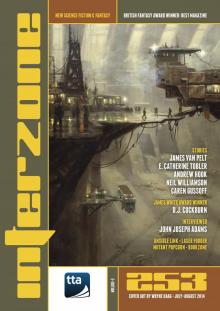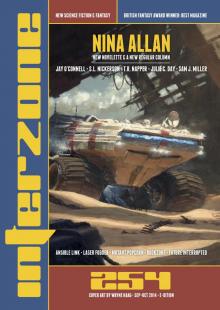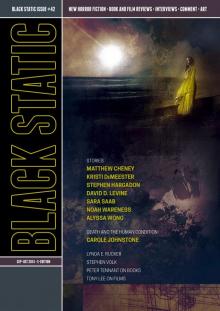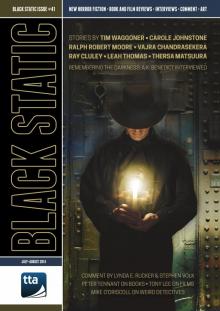BLACK STATIC #41 Read online
BLACK STATIC
Transmissions From Beyond
ISSUE 41
JUL–AUG 2014
ISSN 1753-0709
© 2014 Black Static and its contributors
PUBLISHER
TTA Press, 5 Martins Lane, Witcham, Ely, Cambs CB6 2LB, UK
ttapress.com
EDITOR
Andy Cox
[email protected]
BOOKS
Peter Tennant
[email protected]
FILMS
Tony Lee
[email protected]
ISSUE 41 COVER ART
Richard Wagner
SUBMISSIONS
Unsolicited submissions of short stories are always very welcome, but please follow the basic guidelines on our website
CONTENTS
COMMENT
COFFINMAKER’S BLUES
STEPHEN VOLK
BLOOD PUDDING
LYNDA E. RUCKER
FICTION
NONE SO EMPTY
TIM WAGGONER
illustrated by Vincent Sammy
CAUL
VAJRA CHANDRASEKERA
GHOSTS PLAY IN BOYS’ PAJAMAS
RALPH ROBERT MOORE
illustrated by Joachim Luetke
EQUILIBRIUM
CAROLE JOHNSTONE
THE DRIVEWAY
LEAH THOMAS
THE HUTCH
RAY CLULEY
THE SPIDER SWEEPER
THERSA MATSUURA
illustrated by Richard Wagner
REVIEWS
CASE NOTES
PETER TENNANT ON BOOKS
including interview with A.K. Benedict
BLOOD SPECTRUM
TONY LEE ON DVDS/BLU-RAYS
SILVER BULLETS
MIKE O’DRISCOLL ON TV NOIR
weird detectives
COFFINMAKER’S BLUES
STEPHEN VOLK
STAB WOUNDS
Like many people reading this column, I grew up with the lurid, seductive covers of Pan, Fontana, tales they wouldn’t let Hitchcock make, and the gunmen, gallants and ghosts of Dennis Wheatley. Later I’d sink into the warm, black water of Alberto Manguel’s magical realism, which Amazon now calls “a kaleidoscope from the Magi of the imagination”, consuming countless other paperback anthologies along the way.
Through these, my love of the genre was undoubtedly unlocked (or unblocked, for it felt like a liberation) by such visionary writers as Poe, whose ‘Tell-Tale Heart’, with its unforgettable opening POV – much imitated but never surpassed (even by Robert Bloch’s ‘Enoch’) – and M.R. James with his rising bed sheets, wetness and adjectives reminiscent of genitalia.
“No sex please, we’re ghost stories!” the latter author famously proclaimed – a belief that seems bizarre or even perverse to these ears. But my adolescent self was uninterested in whether his stories contained convincing human relationships. Nor was he, it appears. “If any of them succeed in causing their readers to feel pleasantly uncomfortable when walking along a solitary road at nightfall,” he said, “or sitting over a dying fire in the small hours, my purpose in writing them will have been attained.” (Angry young Colin Wilson, however, was quite dismissive of James, saying his ghosts “could frighten no-one but a nervous schoolboy.” Later the existentialist generously revised his incompetent initial assessment, praising M.R.J.’s scholarly cast of mind and adding “at his best…there is a gentle, ironic delicacy of touch.”)
Robert Aickman is another, very different, master, acclaimed by his many literary admirers not for invoking spectres or putrescent guardians so much as a far more ambiguous feeling of psychic unease. Regarding his classics, such as ‘The Hospice’, David A. Riley has coined the lovely phrase Kitchen Sink Gothic as the antithesis of Jamesian horror. No scholars. No atmosphere in the traditional gothic sense. Instead, as John Coulthard describes it: “The quotidian Britishness of Alan Bennett, darkening into the inexplicable nightmare of David Lynch.”
I love this, but I still have a very soft spot for Conan Doyle’s ‘Playing with Fire’ – for me forever indistinguishable from the 1971 TV version of ‘The Horse of the Invisible’ starring Donald Pleasence as Carnacki, while, for all his expertise in folksy apple-pie-and-Martians, the Bradbury short story that chilled me to the bone, and still does, was ‘The Emissary’.
Another perfect beast is W.W. Jacobs’ ‘The Monkey’s Paw’, while Ambrose Bierce’s ‘Occurrence at Owl Creek Bridge’ reminds us that the best “horror” stories are amongst the best short stories ever written, period. But the genre has indistinct borders, and Graham Greene’s ‘The Overnight Bag’ and ‘A Shocking Accident’ stretch the sinister and outré without ever leaving the realm of the real.
Borges showed me the fantastical can be concise, anecdotal, even read like a footnote in a history book. While at the other end of the stylistic scale Angela Carter’s unapologetically baroque language delivered a wry feminism via twisted, carnivalesque gags and loud, crashing symbolism.
All these authors have been influences on my writing, but none more so than Raymond Carver – whose pared-to-the-bone style almost instructs us to leave out everything except what happens, which is why he is the god to which all screenwriters sacrifice their first born – or the majority of their description, anyway. It’s no coincidence that his brilliant story ‘So Much Water So Close to Home’ has been adapted twice for film (in Altman’s Short Cuts and Ray Lawrence’s Jindabyne).
What I adore about Carver is that he excels in implying a world beyond the story. He tells you everything about a relationship, yet has only shown you a scene between a man and his wife eating breakfast. Reading a collection like his Elephant inevitably led to my appreciation of similar un-showy writers like Tom Wolff, Richard Ford, Bernard MacLaverty and Russell Banks.
Editor of the exemplary Shadows & Tall Trees Michael Kelly agrees that he loves how short stories say so much in so few words. How they spirit you to another place. That they are “the perfect art form”.
Something hard to refute when faced with the evidence of late.
Only Robert Shearman would dare write about a man in Hell sharing a cell with Hitler’s dog (‘Damned if You Don’t’), but the result is a comic turn, expertly handled, hilarious until the final twist of the knife. This story makes you feel guilty for being even remotely entertained, and hits you with an ingenious wake up call, all in a few pages. Tim Lebbon’s unforgettable ‘Discovering Ghosts’ is a masterclass in writing from the heart and touching the soul. Mark Morris continually shows he is at the top of his game with stories like ‘Waiting for the Bullet’ and ‘Fallen Boys’, while Conrad Williams, whose use of language is unparalleled, reaches new heights with a layered story such as ‘The Pike’. Together with the king of haunting brevity, Nicholas Royle, I consider all these writers “uncannologists” who will continue to inspire and excite me.
A more recent inspiration – no, revelation – has been Nathan Ballingrud, whose North American Lake Monsters is an achingly real tapestry of the sort of fears, mistakes, regrets and inabilities to change that curse us as human beings, salted and spiced by the downright weird. These stories do not need to be horror, but horror – here’s the thing – elevates them and makes them sing. The effortless naturalism of the prose is breathtaking, but more importantly, here is someone who knows what horror is for. “Whatever fantastic element is present in these stories, it’s not a primary focus of (the characters’) lives. They react to it, or are illuminated by it. And their reactions are what I really care about.” Failed masculinity, a broken family, frantic struggles not to drown “and sometimes drowning anyway.” Ballingrud sees horror as the only way to express the lives of people, deep down. He reinvigorates genre tropes as
sharpened tools for carving tales with a Carver sensibility. And sensitivity. For instance, in ‘Sunbleached’ he describes a vampire as “a dancer pretending to be a spider” and I’m damned if you need any more than that.
Vitally, he is quoted in a recent interview saying: “I believe self-interrogation is a key to strong fiction. You should write about what you are ashamed of. You have to be merciless with yourself. That’s why I like to write about characters so easy to hate. Writing fiction is, in no small part, about practicing empathy: and if there is a noble purpose in literature, it’s [that].”
This is exactly what I aspire to. Horror is there to desolate, yes, but to demonstrate humanity, not inhumanity. To howl such dilemmas and emotions as sadness, loneliness, grief, anger – in a way that non-genre cannot. “The goal,” as Ballingrud says, “is to be intimate.” Echoing this, Carole Johnstone says, “Horror is supposed to unsettle you, but a good horror story should also move you and make you think.”
And now my time is up. There’s no space left to mention Joyce Carol Oates or Helen Marshall, or Alison Moore whose ‘Small Animals’ and ‘Late’ are heart-stoppingly good. Or James Lee Burke, who blew my mind with thirteen incredible pages called ‘Jesus Out to Sea’. Or Ray Cluley. Or a recent discovery, Aiden O’Reilly, whose terrific ‘The Laundry Key Complex’ appeared in Unthology 4…
Lovecraft’s quote may be true: “The oldest and strongest emotion of mankind is fear, and the oldest and strongest fear is fear of the unknown” – but the unknown voices that lie ahead of me to discover in the future of short story writing produce nothing but a feeling of unbridled joy.
www.stephenvolk.net
BLOOD PUDDING
LYNDA E. RUCKER
BORN THIS WAY
Are horror fans and creators of horror in fiction and film and other mediums born or made? Anyone who has read Ramsey Campbell’s harrowing introduction to his novel The Face That Must Die, which deals with his upbringing in a home with estranged parents and a mother descending into mental illness throughout his childhood and early adulthood, might argue for the latter, but Campbell himself doesn’t make particular claims to that effect in his piece, although certainly those experiences must have informed how well he writes about mental illness in his own fiction. We tend to cherry pick the information we need to draw the conclusions we want: few of us can describe an upbringing quite so gothic as the one Campbell writes about, but few of us can remember a childhood without any shadows. And it is to those shadows that people tend to look when they set out to explain what seems an unnatural affinity for all the things we ought to be doing our best to avoid: the dark, the perverse, the terrifying.
I remain unconvinced, though; I suspect even the sunniest of childhoods might produce lovers of the dark. Separating nature from nurture has so far proved to be a largely impossible task even for those who specialise in such fields, and I can say that my own experience and that of many others with whom I’ve discussed this question is one of being drawn to the imagery of horror and the supernatural before we could articulate it, before we even knew it as something called “horror”. For me, anything would do, from Sesame Street’s Count in his bat-infested castle who always disappointed me by never actually doing anything scary, to the covers of books I was too young and too frightened to read. Pictures of haunted castles, ghosts, monsters – I couldn’t get enough of any of it.
I did face something of a dilemma: I was an easily spooked child, one who had to be carried screaming from a haunted house at the age of seven via the emergency exit. I was also prone to nightmares, but none of that stopped me devouring short horror fiction from the likes of Robert Bloch and Frank Belknap Long and spending many a sleepless night listening for the sounds of the son from ‘The Monkey’s Paw’ returning home – to my home, for some reason – or for the wax figure of Dr Bourdette from ‘The Waxwork’ to step through the wall of my bedroom and slit my throat.
Meanwhile, there was the sense of a more forbidding adult world of horror that ranged from the real to the unreal to the undefined, and all of it might have been real to me.
I pored over the faces of the Manson family on the paperback of Helter Skelter, trying to work out how such ordinary-looking people turned into monsters, all the while too afraid to read even a word of the text. My grandparents had a big coffee table book – I think it was Life Goes to the Movies – and among other photos was a still from Goldfinger of Shirley Eaton covered in the gold paint. “She died of skin suffocation” the book informed me, and I mixed up movies and reality and believed someone had murdered the actress in that manner. I would get out the book and stare at the photograph every time we went back and visited my grandparents. (Much to my surprise, while looking this up to ensure I got the details right, I learned I was not alone in this misconception: there is an entire article on Snopes debunking an apparent urban legend that circulated claiming the actress herself had died in that way due to Eaton’s retirement from acting shortly after.)
I had one family ally in my love of the macabre, and that was my mother. In fact, my mother is partly the reason that the idea of horror being something that wasn’t for women literally never crossed my mind until I was in my late twenties and then only because people told me so. Besides me, my mother was the horror fan of the family, and it was with her that I watched those classics from the 1970s that were shown on network TV in the US – Harvest Home, Burnt Offerings, The Omen.
And then, of course, there was King, and Salem’s Lot, which my mother read along with everything else King wrote in the 1970s and 1980s. I was fascinated with and terrified by the cover, the black paperback copy with the child’s face and a single red drop of blood at her mouth. I remember overhearing my mother talking about the book with a friend. “The part where they had to drive the stake through her heart!” she said, but I misheard and thought she’d said something about skates. For years afterwards, I thought there was a scene in Salem’s Lot where someone had to skate through a gauntlet of vampires.
My mother was also there, along with one of my best friends, with twelve-year-old me and another seminal horror experience: my first viewing of Halloween. And speaking of urban legends and misconceptions about popular media, my friend Lisa and I watched this one with rising hysteria because a boy at school had told us that near the end of the movie, Michael Myers cuts Laurie’s arms and legs off and throws her down into the basement; she then has to crawl up the stairs on stumps and dial the police with her face. As the film hurtled toward its climax, we clutched each other and watched through our fingers, shrieking “Is this the part where he cuts off her arms and legs?”
What a relief it was that the boy had lied, because we adored Laurie Strode. With not an ounce of feminist theory in our heads, we instinctively knew that she was something different from the victims in other slasher movies. For us, she was a genuine heroine and a real survivor. For months afterwards, we talked about Laurie like she was someone we knew, our friend, because she was the kind of girl we wanted to be friends with.
By then I was reading grown-up horror, the novels on which those 1970s movies were based and, of course, King, as well as devouring a series of doubtless low-quality but unputdownable horror novels for kids branded as the Twilight series (not remotely anything like the present-day one).
Within a few years, my tastes would be refined as I would encounter the likes of Ramsey Campbell and Robert Aickman, Shirley Jackson and Lisa Tuttle, Melanie Tem and Steve Rasnic Tem and so many others for the first time, but I had seized the raw material and clutched it close to me without even any conscious thought.
Horror spoke to me in a way no other genre did. Writing horror always came as naturally as reading it; stories just wanted to be horror stories, sometimes subtly, sometimes less so.
One of the things I love about knowing so many other horror writers and readers is what a similar trajectory so many of us have. I’ve been delighted to see in recent discussions on social media, for example, how many of us i
n those pre-internet days used Danse Macabre as a primer to the written work in the field. I have this mental image of us weird horror kids in different places and different countries all making our way along similar scary routes to the same spooky places.
It’s that frisson, the genuine love of the genre, that I think is overlooked and misunderstood by people who aren’t horror fans. Science fiction fans, of which I am also one, talk about a sense of wonder, but my earliest sense of wonder grew out of horror, and certain types of horror still leave me as much awestruck as frightened. It is as though horror wakes something atavistic within us, takes us back to a primal place where terror and wonder are inseparable, and leaves us there in the dark – where we embrace it.
lyndaerucker.wordpress.com
NONE SO EMPTY
TIM WAGGONER
ILLUSTRATED BY VINCENT SAMMY
I approach the Dumpster, a full bag of trash hanging from my left hand. The Dumpster’s concealed behind a high wooden fence, with an opening for residents to step through. A sign on the fence warns, in squiggly hand-lettered words, that there’s no dumpster diving!. Classy.
The Dumpster’s plastic lid is down, but the metal side door is partway open, revealing lumps of white plastic bags identical to the one I’m carrying. But nestled between the mounds is a shock of what looks like brown hair, and the first thought that comes to me is, That’s a head.

 INTERZONE 253 JUL-AUG 2014
INTERZONE 253 JUL-AUG 2014 INTERZONE 254 SEPT-OCT 2014
INTERZONE 254 SEPT-OCT 2014 BLACK STATIC #42
BLACK STATIC #42 BLACK STATIC #41
BLACK STATIC #41